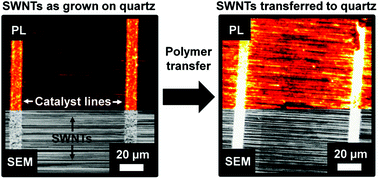Photoluminescence enhancement of aligned arrays of single-walled carbon nanotubes by polymer transfer†
Abstract
The photoluminescence of as-grown, aligned single-walled carbon nanotubes (SWNTs) on quartz is strongly quenched and barely detectable. Here we show that transferring these SWNTs to another substrate such as clean quartz or glass increases their emission efficiency by up to two orders of magnitude. By statistical analysis of large nanotube arrays we show at what point of the transfer process the emission enhancement occurs and how it depends on the receiving substrate and the employed transfer polymer. We find that hydrophobic polystyrene (PS) as the transfer polymer results in higher photoluminescence enhancement than the more hydrophilic poly(methyl methacrylate) (PMMA). Possible mechanisms for this enhancement such as strain relief, disruption of the strong interaction of SWNTs with the substrate and localized emissive states are discussed.


 Please wait while we load your content...
Please wait while we load your content...